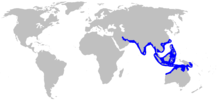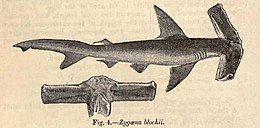Winghead shark
| Winghead shark | |
|---|---|

| |
| Scientific classification | |
| Domain: | Eukaryota |
| Kingdom: | Animalia |
| Phylum: | Chordata |
| Class: | Chondrichthyes |
| Subclass: | Elasmobranchii |
| Subdivision: | Selachimorpha |
| Order: | Carcharhiniformes |
| Family: | Sphyrnidae |
| Genus: | Eusphyra T. N. Gill , 1862
|
| Species: | E. blochii
|
| Binomial name | |
| Eusphyra blochii (G. Cuvier, 1816)
| |

| |
| Range of the winghead shark[3] | |
| Synonyms | |
| |
The winghead shark (Eusphyra blochii) is a
Inhabiting the shallow coastal waters of the
Taxonomy
In 1785, German
In 1862, Theodore Gill placed the winghead shark in its own genus Eusphyra, derived from the Greek eu ("good" or "true") and sphyra ("hammer").[6][7] However, subsequent authors did not accept Eusphyra and preferred to keep this species with the other hammerheads in the genus Sphyrna. Eusphyra was resurrected by Henry Bigelow and William Schroeder in 1948, and came into wider usage after additional taxonomic research was published by Leonard Compagno in 1979 and 1988. Nevertheless, some sources still refer to this species as Sphyrna blochii.[5][8] Other common names for the winghead shark include arrowhead, arrow-headed hammerhead shark, and slender hammerhead.[7]
Phylogeny
| |||||||||||||||||||||||||||||||||||||||||||||
| Phylogenetic tree of hammerhead sharks based on mitochondrial and nuclear DNA[9] |
The traditional view of hammerhead shark
Description

True to its name, the winghead shark's cephalofoil consists of a pair of long, narrow, and gently swept-back blades. The width of the cephalofoil is equal to 40–50% of the shark's total length. The front of the cephalofoil has a slight indentation in the middle and a gentle bump on each side in front of the nostrils. Each nostril is roughly twice as long as the width of the mouth and extends along almost the entire leading margin of each blade. The circular eyes, located at the forward outer corners of the cephalofoil, are equipped with protective
The body is slim and streamlined, with a very tall, narrow, and falcate (sickle-shaped) first
Distribution and habitat
The winghead shark is found in the
Biology and ecology

Several nonexclusive
The winghead shark usually hunts close to the
Life history
The winghead shark is
Initially, the embryo is nourished by yolk and develops in a similar fashion to other sharks. At a length of 4.0–4.5 cm (1.6–1.8 in), the cephalofoil and the fins begin to form. When the embryo is 12–16 cm (4.7–6.3 in) long, the yolk supply begins to run low and folds appear on the yolk sac and uterine wall, which later interlock to form the placenta. At this stage, the embryo has most of the features of an adult, albeit rudimentary and colorless. The blades of the cephalofoil are folded back along the body, and long external gill filaments protrude from the gill slits. At a length of 20–29 cm (7.9–11.4 in), the placenta has formed; the first teeth, dermal denticles, and skin pigmentation appear on the embryo, and the external gills are much reduced in size. By the time the embryo is 30 cm (12 in) long, it resembles a miniature version of the adult.[28][29]
Birthing takes place in May and June off Mumbai and
Human interactions
Harmless to humans, the winghead shark is caught throughout its range using
References
- ^ . Retrieved 19 November 2021.
- ^ "Appendices | CITES". cites.org. Retrieved 14 January 2022.
- ^ ISBN 978-0674034112.
- ^ Cuvier, G. (1816). Le Règne Animal distribué d'après son organisation pour servir de base à l'histoire naturelle des animaux et d'introduction à l'anatomie comparée. Deterville. p. 127.
- ^ ISBN 978-9251013847.
- .
- ^ a b c Froese, R.; Pauly, D., eds. (2011). "Eusphyra blochii, Winghead shark". FishBase. Retrieved May 18, 2013.
- ^ a b Martin, R.A. (1998). "Recent Changes in Hammerhead Taxonomy". ReefQuest Centre for Shark Research. Retrieved May 18, 2013.
- ^ PMID 20138218.
- ^ Cavalcanti, M.J. (2007). "A phylogenetic supertree of the hammerhead sharks (Carcharhiniformes: Sphyrnidae)". Zoological Studies. 46 (1): 6–11.
- ^ ISBN 978-1-921605-59-8.
- ^ ISBN 978-0824818081.
- .
- PMID 19946079.
- S2CID 6841608.
- JSTOR 1446895.
- ^ .
- ^ Pramanik, P.B.; Manna, B. (2006). "Callitetrarhynchus blochii new species (Cestoidea: Lacistorhynchidae) from Sphyrna blochii Cuvier, 1817 from Bay of Bengal at Digha coast, India". Journal of Natural History. 2 (2): 10–15.
- ^ Palm, H.W. (1999). "Nybelinia Poche, 1926, Heteronybelinia gen. nov. and Myxonebelinia gen. nov. (Cestoda: Trypanorhyncha) in the collections of The Natural History Museum, London". Bulletin of the Natural History Museum. Zoology Series. 65 (2). London: 133–153.
- S2CID 18892377.
- ^ Srivastav, A.K.; Capoor, V.N. (1982). "On a new cestode, Phoreiobothrium puriensis n. sp". Indian Journal of Helminthology. 34 (1–2): 82–85.
- ^ Srivastav, A.K.; Srivastava, B.K. (1988). "On a new cestode, Phyllobothrium blochii sp. n. (Phyllobothriidae, Cestoda) from the elasmobranch fish, Zygaena blochii (Cuvier) (Carchariidae, Euselachii) from Puri, Orissa (India)". Helminthologia. 25: 89–94.
- ^ Lakshmi, I.R.; Sreeramulu, K. (2007). "Hysterothylacium ganeshi n. sp (Nematoda-Anisakidae) from the intestine of Shark, Sphyrna blochii (Cuvier)". Geobios. 34 (1). Jodhpur: 29.
- ^ ISBN 978-9251048542.
- .
- ^ Margolis, L.; Kabata, Z.; Parker, R.R. (1975). "Catalogue and synopsis of Caligus, a genus of Copepoda (Crustacea) parasitic on fishes". Bulletin of the Fisheries Research Board of Canada. 192: 1–117.
- ^ Chakravarty, M.; Mandal, A.K. (1961). "A new coccidium, Eimeria zygaenae n. sp. from hammer headed shark, Zygaena blochii". Proceedings of the 48th Indian Science Congress (Roorkee) (Part III): abstract 93.
- ^ a b c Appukuttan, K.K. (1978). "Studies on the developmental stages of hammerhead shark Sphyrna (Eusphyrna) blochii from the Gulf of Mannar" (PDF). Indian Journal of Fisheries. 25 (1–2): 41–52.
- ^ a b c d Devadoss, P. (1988). "Observations on the breeding and development of some sharks". Journal of the Marine Biological Association of India. 30 (1–2): 121–131.
- doi:10.1002/aqc.2274.
External links
- "Species description of Eusphyra blochii" at Shark-References.com
- Fishes of Australia : Eusphyra blochii

